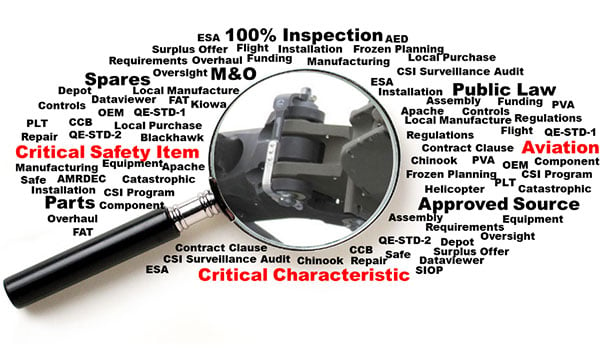
AMRDEC Tech Talk / By Mrs. Quintessa Thomas: When flying, the last thing you want to hear is “Oh crap!” That means trouble and the pucker factor has been introduced. Did someone improperly install the Jesus Nut? Is a misplaced socket tearing up the engine? Or, is a leak starving the transmission because someone erroneously accepted a “nick, dent, or scratch?”

These are the last things on pilots’ minds when trying to figure out how to safely land a crippled aircraft (everyone has done their job right… right?). But, these are a few things that can put them in a hairy predicament. That’s why it’s important for the aviation community to be on the same page with Critical Safety Item (CSI) and critical characteristic (CC) determinations as well as have controls in place to ensure manufacturing and maintenance & overhaul (M&O) facilities have solid CSI programs and adhere to specified requirements.
Synonymous with “flight safety part” and “flight critical part,” an aviation CSI is a part, an assembly, installation equipment, launch equipment, recovery equipment, or support equipment for an aircraft or aviation weapon system if the part, assembly, or equipment contains a characteristic any failure, malfunction, or absence of which could cause a catastrophic or critical failure resulting in the loss of or serious damage to the aircraft or weapon system; an unacceptable risk of personal injury or loss of life; or an uncommanded engine shutdown that jeopardizes safety. DA PAM 95-9, Management of Aviation Critical Safety Items (also a Joint Instruction), assigns the criticality determinations to the cognizant Service Engineering Support Activity (ESA). For the US Army, this responsibility has been delegated to the Director of the AMRDEC’s Aviation Engineering Directorate (AED). Although all Services use this CSI definition as the basis for determining which parts are CSIs, each Service will, in some instances, have differing CSI determinations for the same part. Why, you may ask? One reason is application. The loads placed on a UH-60 helicopter may vastly differ from that which is placed on an SH-60 helicopter, thus requiring different considerations.
The vast majority of CSIs have CCs defined. CCs are classified as applicable to manufacturing, depot, and/or, installation. A part obtained from Army supply will have received government oversight to ensure contractual and statutory requirements are met. Depots or contractors planning to locally manufacture a CSI with a manufacturing CC are required to go through the source approval process and gain approval from the AED prior to manufacture. Manufacturing CCs also become important when attempting to purchase CSIs outside the normal procurement process, e.g. local purchase or surplus offer, which require AED approval. Depot CCs are key when repairing or overhauling a component and should be performed by an approved vendor. Installation CCs are to be adhered to when installing the CSI. CCs associated with CSIs are located in the Joint Services Critical Item Dataviewer, https://remote3.amrdec.army.mil/csiviewer/. This database links to each of the Services’ CSI databases and can also be used to research CSI designations.
Classifying a part as a CSI and assigning CCs means more controls are put in place to ensure parts are manufactured, repaired, and/or overhauled to specified requirements. Vendors producing CSIs with CCs must adhere to Quality Engineering Standard One (QE-STD-1) or their ESA-approved CSI program. Vendors repairing and overhauling CSIs with CCs must adhere to QE-STD-2 or an ESA-approved CSI program. Other requirements include 100% inspection of all CCs, frozen planning, a functioning configuration control board, internal and subvendor audits, stringent recordkeeping practices and, in many cases, serialization. Production Lot Tests (PLTs), First Article Tests (FATs) or Product Verification Audits (PVAs) are required for newly contracted CSIs and are normally performed every 3 years thereafter. To ensure compliance to government contractual requirements, CSI Surveillance Audits are typically held annually at Original Equipment Manufacturers (OEMs) / Primes and Supplier Interface Oversight Program (SIOP) on-site reviews are held at break-out vendors every 3 years, unless findings dictate more frequent visits.
Validating CSI programs is an important factor in ensuring the next flight’s a safe one. And, CSI/CC determination is where it all begins. Determining whether a part should be considered a CSI is clear, if strictly adhering to the definition. However, funding pressures tend to muddy the waters when it comes to ensuring CSIs designated by the ESA are recognized by the OEMs. Nonetheless, it’s our duty to take care of Warfighters so they can focus on completing their mission and returning home.
Mrs. Quintessa Thomas is an engineer and the executive officer for the Aviation Engineering Directorate of the U.S. Army Aviation and Missile Research, Development, and Engineering Center located at Redstone Arsenal, AL.








